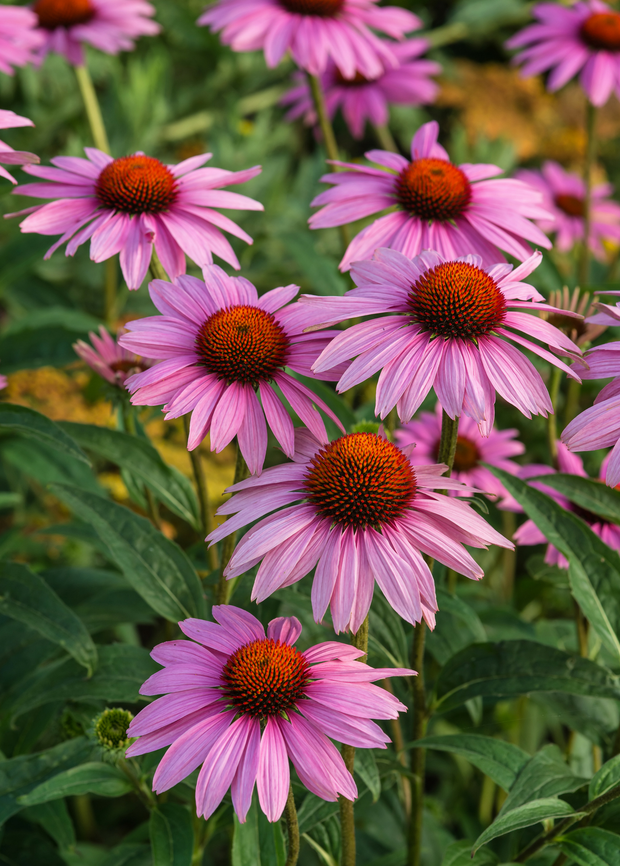
For best results, start seeds indoors in flats and transplant prior to the beginning of the growing season. When starting from seed, daily temperature fluctuations or stratification is required to end dormancy. Depending on the location, it blooms throughout the summer and into the early fall. It seems to do equally well in moist or dry soil, and once established, can tolerate drought conditions. It does well over a broad range of climate zones but does not grow in shady locations. It can now be found in the wild in much of the eastern, southeastern and Midwestern United States as well as in the Canadian Province of Ontario.Īlthough Echinacea became well known and quite popular for its medicinal properties during the later part of the twentieth-century, it is also a wonderful addition to your perennial flower garden. doi:10.1002/ptr.Echinacea purpurea (also known as 'Eastern Purple Coneflower' or simply 'Purple Coneflower') is native to Eastern North American and in the sunflower family. Echinacea plants as antioxidant and antibacterial agents: From traditional medicine to biotechnological applications. Sharifi-Rad, M., Mnayer, D., Morais-Braga, M. Echinacea purpurea: A Proprietary Extract of Echinacea purpurea Is Shown to be Safe and Effective in the Prevention of the Common Cold.

Cochrane Database Syst Rev, 2(2), Cd000530. Echinacea for preventing and treating the common cold. Karsch-Völk, M., Barrett, B., Kiefer, D., Bauer, R., Ardjomand-Woelkart, K., & Linde, K.
#PURPLE CONEFLOWER EDIBLE TRIAL#
A randomized controlled trial of the effect of fluid extract of Echinacea purpurea on the incidence and severity of colds and respiratory infections. From Rudbeckia to Echinacea: The Emergence of the Purple Cone Flower in Modern Therapeutics.

Medicinal properties of Echinacea: a critical review. The embryogenesis indirectly occurred…īarrett, B. In the present study, the callus embryogenesis was examined using benzyl adenine (BA) at three levels (3, 4, 5 mg L^(-1)), 1-Naphthalene acetic acid (NAA) at three levels (0.1, 0.2 and 0.5 mg L^(-1)) with or without activated charcoal (1 g L^(-1)), coconut milk (50 ml L^(-1)) and casein hydrolysate (50 mg L^(-1)) in the MS (Murashige and Skoog 1962) medium. Purple coneflower (Echinacea purpurea (L.) Moench) is a widely used medicinal and ornamental plant. Latest Researchīy Maryam Dehestani-Ardakani on Augat 10:00 am More information available from the John R.
#PURPLE CONEFLOWER EDIBLE SKIN#
The Choctaw used Echinacea purpurea for treating coughs, stomach upset, and sore throats (Flannery, 1999). The Sioux used it for treating wounds and snakebite and as a cure for rabies (Ross, 2016). The Cheyenne used preparations to treat colds and skin conditions (Flannery, 1999). Early settlers to the Midwest also used Echinacea to treat saddle sores on horses (Flannery, 1999). Given that Purple Coneflower is native to such a wide swath of North America, it should come as no surprise that the earliest knowledge of its medicinal properties was attained by Native Americans.

This plant is used to treat common diseases, such as colds, flu, and upper respiratory infections (Ross, 2016). Modern analyses of the Echinacea genus have suggested it may have antioxidant and antimicrobial properties (Sharifi-Rad et al., 2018). However, studies examining the effectiveness of Echinacea purpurea in preventing or treating the common cold have had mixed results (Grimm & Müller, 1999 Ross, 2016) and the most recent systematic review failed to find any statistically significant benefit to the treatment (Karsch-Völk et al., 2014). It is generally considered non or only very slightly toxic (Sharifi-Rad et al., 2018). It is a tall perennial member of the Composite family indigenous to eastern and central North America. Image obtained from: Purple Coneflower ( Echinacea purpurea)Įchinacea purpurea, also called Purple Coneflower, is one of the most widely cultivated medicinal plants in the US (Ross, 2016) and Europe (Barrett, 2003).


 0 kommentar(er)
0 kommentar(er)
